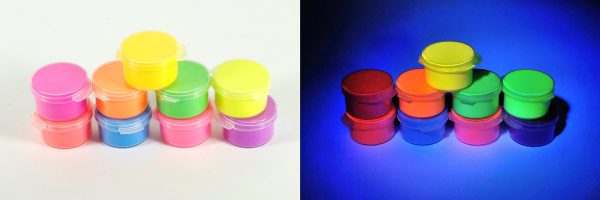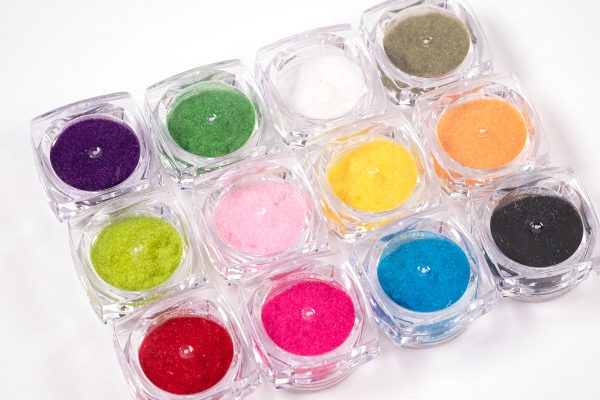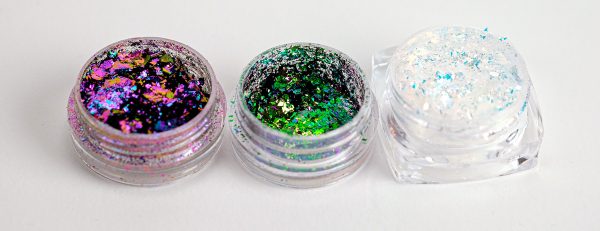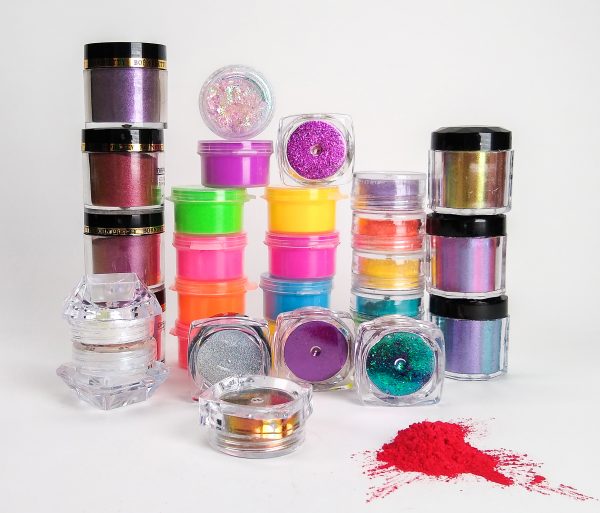Nail Powders and Pigments
In recent years, nail art has become quite a trend. Not only do people go to special salons to have creative nail decorations applied, they also buy the materials to create these colorful treatments at home, themselves. These days any color is available and it goes far beyond simple nail polish. There are resins, acrylics, tips and stick-on nails. You’ll find stickers, decals, and crystals. There are stamps and brushes and fancy templates. With some creative repurposing, we can use all of these materials in our polymer clay art, of course. But there’s one trend that’s particularly fun to use with polymer clay… nail powders.
What are Nail Powders?
Nail powders are powdered pigments, mica, or other powders/particles that are applied to slightly tacky/sticky nail polish to make a colored layer. You can use either regular nail polish or gel polish to create this effect. The general process is shown in this video using chrome, holo, and mermaid powders, but there are many types of nail powders (see below), each with its own effect.
While I love a nice manicure as much as the next girl, that’s not what this article is about. You see, you can apply these powders to any slightly sticky/tacky surface. Such as…yes…unbaked polymer clay. Yes, nail powders can ALL be used to great effect with polymer clay. This is a whole new world of fun. So let’s get busy exploring. I’ll describe the various types of nail powder below and then we will explore them in a Discovery Challenge starting August 1 in the Community.
Types of Nail Powders
Keep in mind that “Nail Powder” isn’t a real thing. Nail powders are marketed to the nail industry, but the materials themselves are nothing new. These pigments, micas, and various types of powders have long been used to make paint, art supplies, and the household materials we have around us all the time. Chinese manufacturers (most of this stuff is made in China) have long sold these materials to manufacturers who buy in bulk. But Amazon, AliExpress, Wish.com, and ebay have created marketplaces that sell directly to consumers like us, making it lucrative for small Chinese sellers to buy in bulk and repackage these materials. That makes them available to us inexpensively in small amounts that are perfect for use as art materials.
You might have heard these called “Born Pretty Powders” because Born Pretty is a company that was one of the first to repackage these powders and market them for nail art. It’s not a specific type of powder, but rather a brand name for repackaged nail art supplies.

Nail powders usually come packaged in non-descript small jars and pots. Here are some various types of nail powders and what they “really” are.
Chrome
Chrome powders are just bright mica powder. Synthetic mica (made from a glass-like material rather than natural mica) is brighter with more reflection than normal mica. But it’s essentially the same stuff. In fact, many mica makers are now using synthetic micas. (Pearl Ex Knox Gold and Hot Copper are synthetic micas.) You’ll get a chrome effect if the mica particles are small, the opacity is high, and the surface is burnished flat. Fun fact: Cernit Metallics and the Cernit Sparkling powders are made from this same chrome-like synthetic mica. Here are some chrome nail powders on Amazon.
Mermaid/Unicorn
The colors of mica are created by applying a metal oxide coating on the surface. If this coating is iridescent, you get Mermaid, Unicorn, or Aurora powders. These white powders appear white or translucent, but reflect different colors. These are similar to Pearl Ex’s Interference colors, but they also have a color shift. That means that as the angle of the light changes, these powders change color. Just imagine mica powder coated with the same stuff that coats iridescent holo film, and you’ve got Mermaid Powders. This comes in several color ranges/shifts. The set you see in the picture below is listed here.

Chameleon
Have you ever seen a car that changes color as it goes by? That’s done with chameleon pigments. Yes, you can buy the same pigments that they use in that paint. Like Mermaid colors, Chameleon colors shift as the light angle changes. You’ll often see 4 or more colors, completely shifting as the light moves. Chameleon colors are pretty opaque, too, so you won’t see much difference in how they appear over different bases. Both Chameleon and Mermaid powders are made with synthetic micas. Here’s a listing on Amazon for chameleon powders.

Glitter
If the shiny coating is applied to plastic film, and then chopped into tiny squares, you have glitter. Glitter can be chunky (more like sequins) or it can be fine. If the glitter is fine enough, it makes a lovely glittery effect for nails. Different from mica, glitter is plastic and can sometimes dull a bit if baked on the surface of your clay. Here’s a listing for basic glitter.

Holo Glitter
Holo glitter has a rainbow shimmer, sometimes known as a “linear holo”. If holo glitter is applied to a surface and then flattened down, you’ll see lines of rainbow colors stretching across the surface as the light shifts. You can see it in the middle segment in the nail video above. Holo glitter can be uncolored (silver) like this one or it can come in a variety of colors. I have this stuff in colors, but I’m just seeing a whole bunch of misleading listings on Amazon at the moment. This listing on ebay makes the colors available individually.
Glow in the Dark
All the glow-in-the-dark things you see nowadays are made with powders that absorb light and then slowly emit it over time. I’ve written about them here. You can buy individual colors or sets. Great fun! There are a ton of listings on all the marketplaces. The sets shown below were bought here.

Fluorescent
Fluorescent pigments absorb light and then reflect it back in a different frequency. Florescent colors are also called neon or day-glo colors. They appear bright in normal light, but they are intensely brilliant under black light. They’re also called UV-Reactive colors. We see these pigments in the Neon ranges of both Cernit and Fimo. But you can buy the pigments and then use them however you’d like. Note: Fluorescent colors are not the same as glow-in-the-dark. They only glow when light is shining on them. Here’s a listing of some fluorescent nail powders.

Light Sensitive
Have you ever seen nail polish that changes color when you go into the sun? It’s popular in the gift shops at tropical vacation spots. The pigments used for this are available for your creating pleasure. I think these would be really fun when added to varnish and used to make your creations change color in the sun. This pigment is fairly expensive. But I’m including it in case you’re interested in trying it. I think it has a great possibility for creating images that only show up in the sun. Imagine earrings with stripes that appear when you go outside.
Heat-Sensitive
You can get pigment powders that change color with temperature. You’ve probably seen drinking cups that turn colors when you add ice. I have some that are white at room temperature and they turn colors when they get warm (I think they’re the same as in this video. Other types have specific temperature points where they switch from one color to another. Not all of the colors are heat-safe, so you will probably want to use these after baking by making a paint with some varnish. Here’s a listing with a large assortment of individual colors in bulk. Pricey, but interesting. To find these, do a search for “thermochromic pigment”. This listing has a variety of types.
Matte
Matte pigments are a lot like pastels. They’re just pigment powder. Use them interchangeably with pastels, Pan Pastels, or chalks. These aren’t commonly sold as nail powders and you’ll do better with a box of soft pastels from the craft store. 🙂
Sugar
Some nail powders are mixtures of glitter and pigments. Sugar nail powders tend to have clear, bright, large particle mica or glitter and some color. This gives an interesting sugar-frosted appearance that sparkles like glitter but has a more pastel appearance. Here’s a pretty listing for some sugar-style nail powder.
Velvet
I do not want velvet nails. But it’s a thing apparently. This stuff is just flocking powder. Yes, the slightly fuzzy-looking fibers that coat plastic toys from our childhoods. (Mine always attracted cat fur.) But hey, this flocking powder is available in sets of colors as “velvet nail powder”. What happens if you mix this into clay? Hmm! Some colors of Cernit Nature seem to have flocking powder mixed in (along with glitter) to create the speckles. This also appears to be what Sculpey used in the old Granitex colors.


Chameleon/Unicorn Flakes
These are FASCINATING materials. They’re essentially Chameleon and Unicorn mica before it’s ground up. The flakes are chunky, each one a little color-shifting mirror. They’re heat-safe, made from a glass-like synthetic, and are very fragile. You might know these as Lumiere Lusters (a product produced by Jet Age Studio). But you can also buy them as nail powders. It’s the same stuff. Do not use this stuff in a breeze, however. It flies everywhere. I just bought this set of colored chameleon flakes last week. And here’s the corresponding mermaid/unicorn flakes in the same brand. They’re both nice sets.

Chrome Flakes
Visually similar to the above Chameleon flakes, these flakes are just a basic metallic color without the color shift. They’re NOT, however, the same material as the Chameleon flakes. These appear to be ground-up versions of the “cheap Chinese metal leaf” that I talked about here. (Btw, they’re not metal, either.) These are fine in the oven at clay temps, but they’re not heat-safe at high temps the way the chameleon flakes are. Even though this listing says they’re chameleon flakes, you can tell that they’re not. They’re just metallic chrome-like flakes.
Using Nail Powders with Polymer Clay
So once you have some of these nifty powders, how can they be used? As I suggested above, yes, they can be rubbed onto raw, unbaked polymer clay with a finger or with a brush. After baking, you’ll usually need to add a coat of varnish or something to keep the powders from rubbing off. In the case of sparkly or shiny powders, a glossy varnish (or even resin) will intensify the shine. But for the matte pigments, you’ll probably want to use a matte varnish. (Need a good varnish? Choose from the ones I’ve reviewed here.)

Make Paint
But that’s just ONE way to use these powders. Did you know that these pigments and powders are also what’s used to create paint? So you can add these powders to a bit of varnish (in a tiny cup) to make your own paint. That can be used with stencils, to add highlights, to apply to baked clay. You can even experiment with crackle effects as discussed in my Crackle Compendium. Yes, some varnishes will crackle when dry, meaning you can make your own crackle paint to use on raw clay. Try adding these powders to acrylic gel medium to make your own impasto style or textured paint. There are SO many ways to go here.
TIP: It takes a lot more pigment than you’d think. So always start with pigment and then add medium. Otherwise, you’ll end up with a sparse wash rather than a pigment-dense paint.
Mix Into the Clay
And yes, try mixing the powders into your favorite translucent polymer clay. I have an article about using glow-in-the-dark powders, but I’m sure you can see where this has possibilities with other powders, too.
Textures? Yes!
And instead of just applying the powders to a flat surface, explore the world of texture. Use texture sheets, stamps, or stencils to create a texture on raw clay. Then apply powders selectively to the high spots, either with a brush or with a finger. Then flatten the texture. Try stretching it. Add a second color of powder. Start experimenting! And if you screw it up? Just wad up the clay and mix the powders in. Doesn’t hurt a thing (and you get new effects)!
Where to Buy Nail Powders?
Nail powders aren’t as popular as you’d think. I can’t get a manicure done with nail powders in my city, and I can’t go to Sally Beauty and buy nail powders. But due to the recent explosion in Chinese sellers in online marketplaces, you can certainly buy nail powders online. But it’s not so simple to just search for “nail powders”. There’s something you need to know first. And this is important.
Don’t Buy Acrylic Dip Powders
Also popular right now are “dip powders”. This process is HUGELY popular and readily available at your local nail salon. Dip powder is acrylic powder that melts when you apply a special solvent liquid, making a smooth surface. Because pigment or mica powders can also be included in the mix, dipping powders come in a huge array of colors. You can watch this video about dip powders if you want to learn more about them.

Although dip powders DO contain pretty colors and fancy powders, dipping powders contain acrylic resins and should not be baked. If you see the words dip, dipping powder, or acrylic, then it’s the wrong stuff. It won’t work for polymer clay. Skip that listing and move to the next one. (Note: I looked at the MSDS for these things. They’re not safe or natural. Every component of acrylic nails, either dip or conventional, is either toxic or allergenic. Nasty stuff.) Nail powders, themselves, are not toxic, however. Just the acrylic, resin, and solvents are toxic and/or hazardous.
Check the Cheap Marketplaces
If you do a search on Amazon, AliExpress, Wish, or similar marketplaces for “nail powders”, many (if not most) of the listings will be for these dip powders. Most but not all. The ones you want will never include the words “acrylic” or “dip” in the listing. I’ve included Amazon affiliate links above for each type of powder so you can see what the listings look like and hopefully find something similar where you live.
If you’re going to order from these marketplaces, here are a few tips.
- AliExpress is a marketplace in China and nearly everything ships from China. Delivery is usually about 3-4 weeks. They do ship worldwide. Prices can be remarkably low, sometimes nearly free.
- Pay careful attention to Amazon listings. If you’re not choosing Prime shipping, they can often have long delivery times. That’s often cheaper, however, and is a good option if you have time.
- You might not get what you expect. Let’s just say that descriptions and photos are…um..creative, especially on AliExpress.
- Read carefully. Listings are often very misleading. This listing isn’t for several colors of holo glitter. It’s one color, shown over several colors of nail polish.
- Sets often contain many types of powder in one listing. This set contains chrome powders, regular (pearlescent) mica, holo glitter, and mermaid powder. Note that while they say one of the colors is “chameleon”, it’s not. It’s just an interference color.
- Name brands are generally not “real” or “established” companies and customer service is spotty at best.
- Amazon is more expensive, but you’ll get their customer service and guarantees. If you’re already a Prime member, this is likely your best option.
- You may end up buying annoyingly small quantities. But for polymer clay, this doesn’t matter so much. Enjoy!
Not Just Nail Powders
These same powders, pigments, and mica might be packaged and marketed for nail art, resin art, slime making, soapmaking, etc. Because polymer clay is so versatile, we can use these fun powders in a variety of ways, making them quite useful. And fun. You’ll also find many of these powders marketed to other crafts, not just nail art. Check them out and see what you can find.

You can, of course, also find many of these same powders sold by more traditional companies. You’ll usually get larger quantities and higher prices. Solar Color Dust is one that sells a huge array of specialty pigments. If you find a good company that carries these interesting pigments and powders (beyond the usual micas), please share the links in the comments.
Okay, Ready for a Challenge?
Coming on August 1, I’m bringing a new feature to Blue Bottle Insiders. Knowing information like this is one thing, but it doesn’t really help us apply it to our creations. To help us explore topics in-depth and integrate what we’ve learned into our art, I’ve started a monthly series called Discovery Challenges. It is an exploration and interactive discovery around a new topic. For the first month, we’re tackling the world of Nail Powders. Head over to the community now and get started!
Nail Powders and Pigments Read More »


